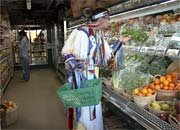World Upside Down
dal 29/9/2006 al 3/3/2007
Segnalato da
Ahmoo Angeconeb
Lori Blondeau
T.C. Cannon
Renee Cox
Jack Daws
Rosalie Favell
General Idea
Cheryl L'Hirondelle
Terrance Houle
Jarusha Brown
Goyce Kakegamic
Jim Logan
Shelley Niro
Roger Shimomura
Yinka Shonibare
Richard William Hill
29/9/2006
World Upside Down
Walter Phillips Gallery, Banff
The exhibition explores how contemporary artists use strategies of symbolic inversion as a playful form of social satire

Ahmoo Angeconeb
Lori Blondeau
T.C. Cannon
Rene'e Cox
Jack Daws
Rosalie Favell
General Idea
Cheryl L'Hirondelle
Terrance Houle & Jarusha Brown
Goyce Kakegamic
Jim Logan
Shelley Niro
Roger Shimomura
Yinka Shonibare
Curated by Richard William Hill
The world upside down is one in which the symbolic order is turned on its head. It is a world visualized by artists where killer rabbits hunt humans and Superman is a hero of the Soviet Union. It is the Planet of the Apes and a planet where British aristocrats lose their heads when they find themselves dressed in “African" fabrics. In each inversion an artist turns a hierarchical dichotomy on its head, but in most cases the dichotomy itself doesn’t survive the trip. It breaks down under the strain of its own absurdity and for a moment we are liberated from its tyranny through this very particular form of social satire.
As an artistic strategy, symbolic inversion has the potential to illuminate and challenge the visual conventions that police social hierarchies. When power relations are suddenly turned on their head, we have the opportunity to recognize that some behaviours that we take to be natural and necessary are merely conventional - and perhaps not in our interests. For this reason, contemporary artists using inversion tend to seek out existing hierarchy, often satirizing the most venerated works in the Western canon. For example, Jim Logan’s The Diner’s Club, No Reservations Required inverts the codes of gendered and racialized representation in Manet’s, De'jeuner sur l’herbe. Yinka Shonibare has played similar tricks with canonical works. In Shonibare’s Mr. and Mrs. Andrews without their Heads, the artist has restaged Gainsborough’s famous painted portrait as a sculpture, but has decapitated the sitters, removed the landscape and dressed the subjects in colourful “African" fabrics that themselves have complex, hybrid colonial histories. Similarly, General Idea turn high modernist formalism on its head by introducing the previously repressed content of the AIDS crisis loose on icons of modernity. Robert Indiana’s classic 1960s “Love" graphic now reads “AIDS".
Although this exhibition will focus primarily on how contemporary artists use inversion critically, it will also draw on works that will give historical depth and pop cultural breadth to the phenomenon. Perhaps the most influential example of symbolic inversion in popular culture was the 1968 film Planet of the Apes, and a number of posters and stills will be included in the exhibition, including one of Charlton Heston’s character sharing a kiss on the lips with the chimpanzee Zira. Also on display will be the DC comic Superman: Red Son, written by Mark Millar. Red Son posits an alternate comic book reality in which Superman’s rocket landed in the USSR and Superman grew up on a collective farm in the Ukraine to become a Soviet rather than American hero. In the Shadow of No Tower’s, Pulitzer Prize winning cartoonist Art Spiegelman contemplates how Bush’s America seems to have turned itself upside down in response to the calamity of the September 11th attacks.
No exhibition on symbolic inversion would be complete without killer rabbits, a theme that begins in the margins of medieval illuminated manuscripts and carries through to “the most foul, cruel, and bad-tempered rodent you ever set eyes on" in Monty Python and the Holy Grail. Visitors will also be welcome to take home a facsimile of a broadsheet woodblock print from the 17th Century originally published by Ewout Muller and reproduced in 1971 by C.F. Van Veen in Drie eeuwen Noord-Nederlandse.
This exhibition also extends out into public spaces to include a commissioned billboard and bus project by Terrance Houle (with Jarusha Brown) who use photography and video to parody the complexities of contemporary Aboriginal identity. In his Urban Indian Series, Houle depicts himself going about the tasks of daily life - shopping for groceries, working at the office - while dressed in his powwow regalia, highlighting the perceived but far from actual schism between traditional Indigenous identity and contemporary life.
Presented as part of the exhibition, Terrance Houle’s public performance, Casting Call, involves Aboriginal collaborators “auditioning" for roles in famous Hollywood westerns. Casting Call is reactionary to the Hollywood practice of casting white actors in “Indian" roles. Houle’s performance not only undoes this convention, it humorously destroys the credibility of Hollywood stereotypes in the process. Casting Call will take place in the gallery on January 11, 2007.
Offsite projects: Terrance Houle and Jarusha Brown
Urban Indian Series (2006)
tri-side billboard, September 25 to October 23, 2006 (16th Avenue westbound near Canada Olympic Park in Calgary)
Terrance Houle and Jarusha Brown
End Trail/Not End Trail (2006)
Opening reception September 30, 2 - 4 p.m.
End Trail/Not End Trail, Banff Transit project, December 15 to February 15
Casting Call, performance January 11,
2 - 5 p.m. and 7 - 9 p.m.
Reception starting at 8 p.m.
The Banff Centre - Walter Phillips Gallery
107 Tunnel Mountain Drive - Banff
Hours: Year Round, Wednesday through Sunday, noon to 5 p.m. Thursday, noon to 9 p.m. Closed public holidays and in between exhibitions for installation purposes. Closed December 22 to January 3.
Admission to the Gallery is free and donations are welcome.



